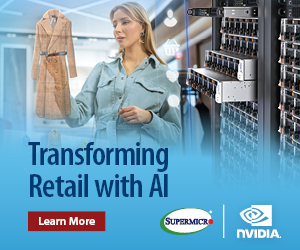Connectivity: the hidden backbone of retail innovation
Startup specialist Daniel Groves argues that businesses must be prepared to embrace retail innovation to stay ahead and, in doing so, should not overlook the vital role connectivity has to play
Valued at £468 billion in 2024, the British retail sector is thriving. However, with shifting consumer behaviours, rising operational costs, and increased competition, retail is evolving, and businesses must be prepared to embrace retail innovation to stay ahead.
Prioritising connectivity is key to future-proofing your business, meeting demand, and exceeding customer expectations while achieving operational efficiency and excellence.
In this article, we will examine why connectivity is crucial in retail, and how you can adopt it to streamline processes, boost productivity, and maximise profits.
What is connectivity in retail?
Connectivity in retail enables the efficient and secure integration of digital and physical systems, processes, and communications, facilitating seamless interactions between them. It enables omnichannel shopping experiences, providing customers with seamless, personalised interactions with retail brands.
However, it's not just customers that benefit from connectivity. It can also significantly enhance operations and corporate communications between teams, making it a vital yet often overlooked aspect of modern retail businesses.
Meeting customer expectations in a digital world
Modern consumers are used to the convenience of ecommerce, and often apply similar expectations when shopping on the High Street. Therefore, retail stores must digitally transform to remain competitive in the future of retail.
Providing seamless online-to-in-store experiences and hybrid shopping solutions, such as click-and-collect, gives consumers the ability to shop however and whenever they want.
'Retailtainment' - where retail meets entertainment
Shoppers are seeking more from their shopping experience, wanting to have an experience that ecommerce alone cannot provide. The rise of 'retailtainment' (retail and entertainment) is leading to customers looking to create memorable moments when shopping in-store, seeking experiential commerce, with interactive stores and social media integration.
In response, retail businesses are increasingly adopting emerging consumer technologies, such as augmented or virtual reality, as part of the in-store consumer experience. Innovations in retail technology are allowing brands to create immersive experiences for customers, blending the brick-and-mortar store with an augmented or virtual store.
Fitting out changing rooms with smart mirrors allows customers to try on clothes virtually, request different styles or sizes, and even pay directly from the fitting room, creating a more enjoyable experience for consumers and improving efficiency for retail workers.
For these developments to run smoothly, robust interconnectivity is pivotal to ensure that the immersion is uninterrupted by slow connections or low latency.
Smart building connectivity is no longer a nice-to-have; it's central to how physical stores seamlessly and successfully integrate with online shopping and even social commerce.
Operational benefits of connectivity
Alongside offering a range of payment options, interconnectivity can also ensure that point-of-sale systems (POS) operate efficiently, even during the busiest shopping periods.
Even if a POS system is down or delayed for a short period, it can significantly impact the customer experience, leading to frustration and a negative perception of the brand. Similarly, the compounding impact of slow and disrupted POS systems can pose a real threat to sales.
With one third of shoppers using digital payments, retailers must be equipped to process a range of payment methods. From digital wallet payments, such as Apple Pay or Google Pay, to pay-over-time options, customers expect to be able to pay in a way that is most convenient for them. By accepting a full range of payment types, businesses can ensure they are future-proofed.
Similarly, providing a variety of POS options can create dynamic customer service that adapts to different consumer habits. Installing self-checkout options creates opportunities for customers to access convenient checkout services, while retaining traditional POS stands creates a hybrid POS setup.
Alternatively, investing in portable POS is a great option that allows retail workers to take payments throughout the store, rather than in a fixed spot. This enables sales assistants to be visible on the shop floor, providing a reassuring presence for customers and a proven deterrent to shoplifters.
Interconnectivity is crucial to the seamless operation of POS systems and plays a vital role in the profitability and performance of retail stores.
Safer security for staff and shoppers
Having a secure network is one of the best ways to keep customer and staff data and information safe from potential cyber attacks.
Retailers handle and retain large amounts of personally identifiable information (PII) for both their customers and staff. While adhering to GDPR can provide a certain degree of protection. However, resilience against cyber attacks is the best way to instil confidence in your business's ability to protect sensitive data.
While a secure network infrastructure enhanced by connectivity allows you to securely process encrypted payments, protecting shoppers from external security risks, its primary benefit is in protecting against harmful ransomware and malware attacks.
Interconnectivity can ensure that businesses have transparent security protocols, robust data encryption, and adhere to regulatory compliance to maintain the integrity of personal data for customers and retail workers.
Improved inventory management
High-speed connectivity enables real-time stock availability information, ensuring that retail workers can offer shoppers accurate inventory updates while they are shopping in-store.
Similarly, it can drive footfall when used in conjunction with ecommerce shopping, allowing customers to check stock availability of their local stores. This capability is advantageous when online inventory is limited or even sold out.
Real-time inventory data tracking can also optimise supply chain coordination and help predict future allocations based on customer demand.
Streamline systems management
Retail depends on various systems to enable planning and communication between staff and customers alike. From enterprise resource planning (ERP) to customer relationship management (CRM) systems, connectivity can help retail businesses streamline their operations.
From a staffing perspective, ERP can help retail managers to plan resources based on data, using trends to predict periods of increased footfall and resourcing accordingly. Strong connectivity can enhance this process by collecting and analysing real-time data, without a delay, which could lead to costly resourcing errors.
When running at optimum efficiency, CRM systems can also help retailers strategically communicate with customers, allowing them to collect data and analyse shopping habits to provide personalised offers or product recommendations. This capability can also be used to notify customers of stock changes, such as when a product they are looking for becomes available in the store, via email or SMS, thereby improving the likelihood of customers returning to the store rather than searching online.
Connectivity is key when it comes to integrated systems that enable retail managers to make data-driven decisions, benefiting both their stores and customers.
Final thoughts
Retail innovation is crucial for the future of retail, and connectivity can enable businesses to remain agile in an ever-evolving digital landscape.
Connectivity can improve the business at all levels, and its impact will enhance the brand experience for everyone who interacts with you.
From enhanced in-store experiences and personalised product recommendations straight to their inbox, to accurate inventory management and data-driven resource planning, connectivity is the driving force behind future-focused retail managers looking to embrace digital transformations.
Daniel Groves is a Startup Growth Specialist.





